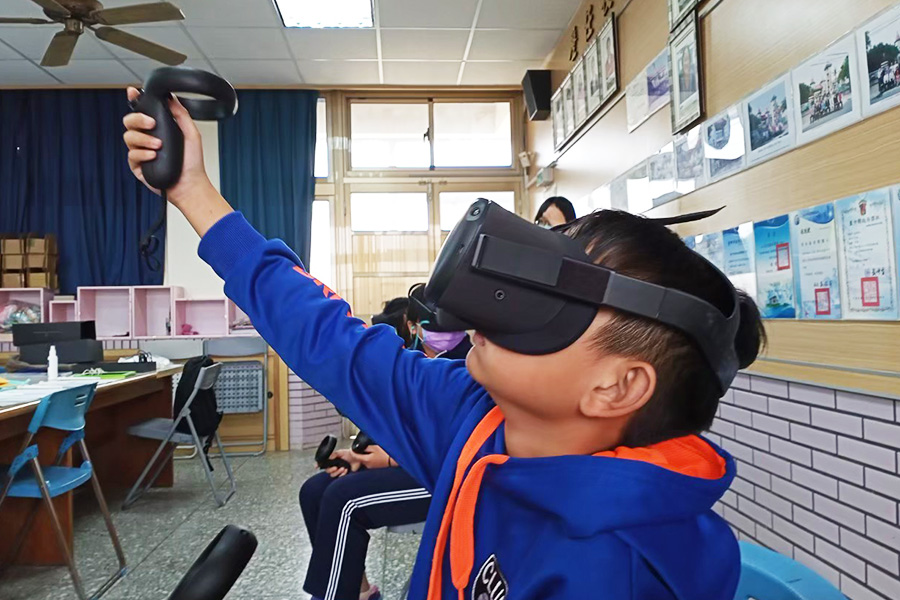In recent years, immersive virtual reality (IVR) technology has made significant advancements. People can now simply put on a headset and be transported to a different world. However, previous research on the effectiveness of virtual reality in enhancing student learning has primarily focused on its affordance to improve spatial abilities, experiential learning, intrinsic motivation, and engagement. Silvia Wen-Yu Lee, a distinguished professor at the Graduate Institute of Information and Computer Education at National Taiwan Normal University, led a research team to further analyze the impact of IVR and concept maps as advanced organizers on elementary school students' science learning.
Wen-Yu Lee specializes in science education, educational technology, and digital learning. Reflecting on her motivation for this research, she has been interested on virtual technology since 2012. Collaborating with professors in related fields, she conducted a systematic literature review and found that the available literature about augmented reality and virtual reality was limited and that this field was less developed compared to other educational technology research areas. Despite the extensive discussion of augmented reality and virtual reality over the past five years, there are still many unresolved questions in existing research about how to effectively integrate new technologies with educational materials to achieve educational objectives.
"Can virtual reality enhance student learning?" became the central question driving the research team. Five years ago, Silvia Wen-Yu Lee led her first project related to virtual reality, funded by the National Science and Technology Council. In her first study, a total of 74 sixth-grade students participated in the study, where they were randomly assigned to either the advanced organizer group (experimental group) or the non-advanced organizer group (control group). The study aimed to evaluate students' understanding of plant concepts through a science test.
The primary goal of the research was to examine the structural relationships between students' cognitive curiosity and affective factors, including presence, control and active learning, positive learning emotional engagement, and negative learning emotional engagement. Additionally, the study aimed to analyze the learning outcomes of the experimental and control groups. Data analysis was conducted using Analysis of Covariance (ANCOVA) and Partial Least Squares Structural Equation Modeling (PLS-SEM). To ensure the quality and safety of the user experience, students engaged in the virtual reality learning activities in small groups of four to six at a time.
In the experimental group, teachers introduced students to advanced organizers and concept maps, providing an overview of the knowledge they were about to learn and explaining how to operate the VR equipment. Conversely, the control group students did not receive any explanation of the advanced organizers; they only received instructions on how to use the VR equipment before beginning the practical activities. The results showed that students in the experimental group scored significantly higher on science concepts compared to those in the control group.
In addition to investigating learning outcomes, the research team explored the connection between learning and curiosity. Silvia Wen-Yu Lee explained that educational psychology defines learning curiosity in two ways: one is the desire to learn because of not knowing (deprivation-type curiosity), and the other is the desire to learn because of interest (interest-type curiosity). The research team was curious about whether the question "What do I not know yet?" plays a role in learning when children engage with emerging technologies. They aimed to further explore the interactions between these two types of learning curiosity and the presence or absence of advanced organizers.
The results showed that learners with high interest-type curiosity experienced a profound sense of presence in virtual reality, along with more positive learning emotions, a stronger sense of control, and increased motivation for active learning. In scenarios with advanced organizers, deprivation-type curiosity did not lead to any significant enhancement in emotional factors, nor did it significantly predict learning outcomes. However, in environments without advanced organizers, students with high deprivation-type curiosity exhibited greater positive learning emotional engagement.
Notably, the research team found that while positive emotions experienced by students using VR can lead to positive learning outcomes in science, a high sense of presence can have a negative impact on learning. Silvia Wen-Yu Lee pointed out that the study revealed a counterintuitive result: "High presence correlates with low learning outcomes." Upon further examination of the literature, it was found that presence in virtual reality is a double-edged sword. While presence draws students to use VR and sparks their interest, a high level of presence can cause students to focus solely on what interests them and the immersive experience itself, hindering cognitive benefits.
Silvia Wen-Yu Lee believes that when students experience a high sense of presence in virtual reality without corresponding learning benefits, it is essential to reconsider the purpose and effectiveness of using VR in education. In other words, if the goal is merely to foster positive emotions and motivation through VR, designing for high presence can be beneficial. However, for educational applications that aim for deep thinking and learning, the design of presence needs to be balanced. Educators may need to reconsider the level of presence or provide additional instructional support to ensure that students achieve their learning objectives while still benefiting from the immersive experience.
In primary and secondary education, a growing number of schools are allocating budgets to purchase virtual reality equipment. However, VR involves not only the high cost of hardware, but also significant expenses to optimize software. Silvia Wen-Yu Lee pointed out that there are now many paid and even free platforms that allow teachers to create their own teaching materials. She emphasized that more important than cost is for teachers to consider whether the content of the materials genuinely aids student learning and enhances learning outcomes through virtual reality. (This article was provided by The Center of Public Affairs.)

Figure 1: Student using VR
Source:Lee, S. W. Y., Hsu, Y. T., & Cheng, K. H. (2022). Do curious students learn more science in an immersive virtual reality environment? Exploring the impact of advance organizers and epistemic curiosity. Computers &Education, 182, 104456. https://doi.org/10.1016/j.compedu.2022.104456



